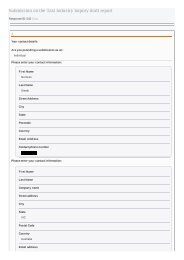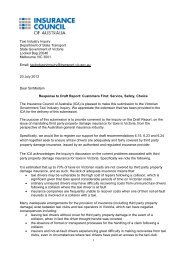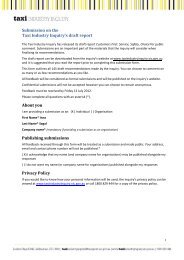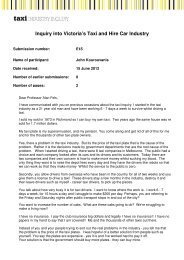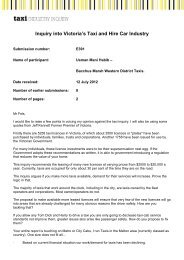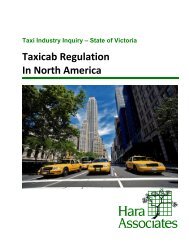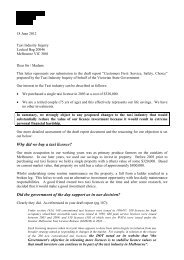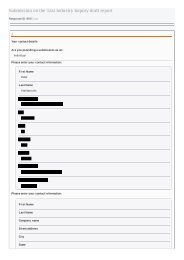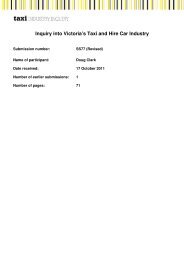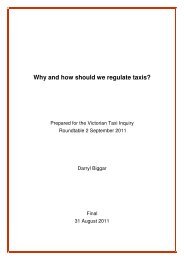Part D â Understanding and improving industry performance (PDF ...
Part D â Understanding and improving industry performance (PDF ...
Part D â Understanding and improving industry performance (PDF ...
Create successful ePaper yourself
Turn your PDF publications into a flip-book with our unique Google optimized e-Paper software.
The inclusion of assignment fees in the fare model has<br />
been a source of contention in the past <strong>and</strong> continues<br />
to be challenged today. The Foletta review argued that<br />
licence market values should not be included in the fare<br />
model <strong>and</strong> noted that the Victorian Taxi Association (VTA)<br />
had agreed with this view. The McQuillen review (which<br />
examined the KPMG review) sought to challenge the<br />
view that licence values <strong>and</strong> assignment fees resulted<br />
in higher fares because “only operating costs have<br />
ever been considered by the Victorian authorities in<br />
the determination of taxi fares.” 17 In any event, given<br />
that large numbers of operators have been incurring<br />
assignment costs since the time of the Foletta review, the<br />
inquiry’s view is that this is strong evidence that fares in<br />
the past were based on inflated cost estimates. The cost<br />
surveys undertaken by the ESC in 2005 indicated that,<br />
while operator returns were considered to be ‘low’, 18 the<br />
cost base for making this comparison included either<br />
$19,213 (2000) or $20,580 (2004) in assignment costs. If<br />
this cost was included instead as part of the return to the<br />
operator, these returns would be very high. 19<br />
The approach taken by the ESC in 2005 <strong>and</strong> 2008 reflects<br />
that assignment costs are either a real cost to an operator<br />
(who does not own a licence) or an opportunity cost to<br />
the licence owner (the value that could be realised by<br />
assigning it to someone else). The ESC also noted that<br />
this causes a circularity between fares <strong>and</strong> assignment<br />
values: higher fares lead to higher assignments <strong>and</strong> then<br />
higher fares. To avoid circularity in the fare model, the<br />
ESC adopted a methodology in 2008 that decoupled<br />
assignment fees in the fare model from actual assignment<br />
fees paid by operators. Consequently, the value used in<br />
the fare model to calculate the appropriate change in fares<br />
was somewhat below the real figure: just over $20,000 as<br />
opposed to the then current rates of just below $30,000<br />
per annum.<br />
2. Meeting dem<strong>and</strong> at peak times<br />
Many submissions to the inquiry describe issues with<br />
dem<strong>and</strong> at certain times. The main concerns reported<br />
to the inquiry are availability late at night on weekends in<br />
Melbourne <strong>and</strong> general availability in outer metropolitan<br />
<strong>and</strong> regional areas.<br />
• In Melbourne, taxis are the only available transport<br />
service operating on Saturdays <strong>and</strong> Sundays in the<br />
early hours of the morning in the CBD other than<br />
Nightrider bus services. At these times, there are<br />
still significant numbers of people in the city. Issues<br />
relating to the poor availability of taxi services during<br />
these times include very long wait times at ranks,<br />
frustrated customers walking onto the road to hail<br />
taxis <strong>and</strong> conflict between customers while trying to<br />
obtain a taxi.<br />
• Local councils <strong>and</strong> businesses report insufficient<br />
taxi services in outer metropolitan areas. Some of<br />
these areas have only one or two local operators,<br />
severely limiting the availability of taxis for short trips<br />
by residents. Users in these areas report long wait<br />
times for taxi services during peak periods <strong>and</strong> that<br />
taxis sometimes never arrive or are often late after<br />
first taking other bookings closer to the city. Councils<br />
also report that operational limitations associated<br />
with the interface between the outer suburban <strong>and</strong><br />
metropolitan taxi zones contribute to the difficulties<br />
residents experience in accessing key services that<br />
are in the metropolitan zone, with residents often<br />
refused travel in both directions.<br />
• In regional Victoria, taxi users, councils, businesses<br />
<strong>and</strong> community groups report problems with service<br />
availability, including taxi numbers failing to keep pace<br />
with population growth in large regional cities, long<br />
wait times in some areas, a shortage of WATs, limited<br />
choice <strong>and</strong> flexibility in services (especially in smaller<br />
towns <strong>and</strong> remote communities) <strong>and</strong> poor integration<br />
with public <strong>and</strong> community transport. Some regional<br />
tourism destinations suffer from insufficient taxi<br />
services during periods of high visitor numbers.<br />
These submissions are supported by the evidence<br />
obtained from surveys conducted by the inquiry:<br />
20 per cent of all problems reported with taxi services by<br />
respondents to the Latitude Insights Survey of Consumer<br />
Detriment occur on Saturday nights between 7pm <strong>and</strong><br />
4am when accessibility is at its lowest. 20<br />
17 McQuillen, Rob PSM (2001), Op. Cit., p. 21<br />
18 There also appears to be some confusion in the ESC report about the<br />
appropriate benchmark for measuring the significance of this return.<br />
The ESC calculates a return on sales (revenue) of 3.8% <strong>and</strong> 3.6% for<br />
the 2000 <strong>and</strong> 2004 years respectively. However, returns on sales are<br />
of themselves meaningless because whether they are reasonable or<br />
not depends on the amount of capital that has been invested <strong>and</strong> on<br />
which a return is required. If only capital-related items are included as<br />
costs (~$35,000 per vehicle per annum), then a return of over $4,000<br />
is in excess of a 10% return on capital employed<br />
19 Either on a return on sales basis or a return on capital employed<br />
basis, as discussed in the footnote above<br />
20 Latitude Insights (2012), Op. Cit.<br />
184




